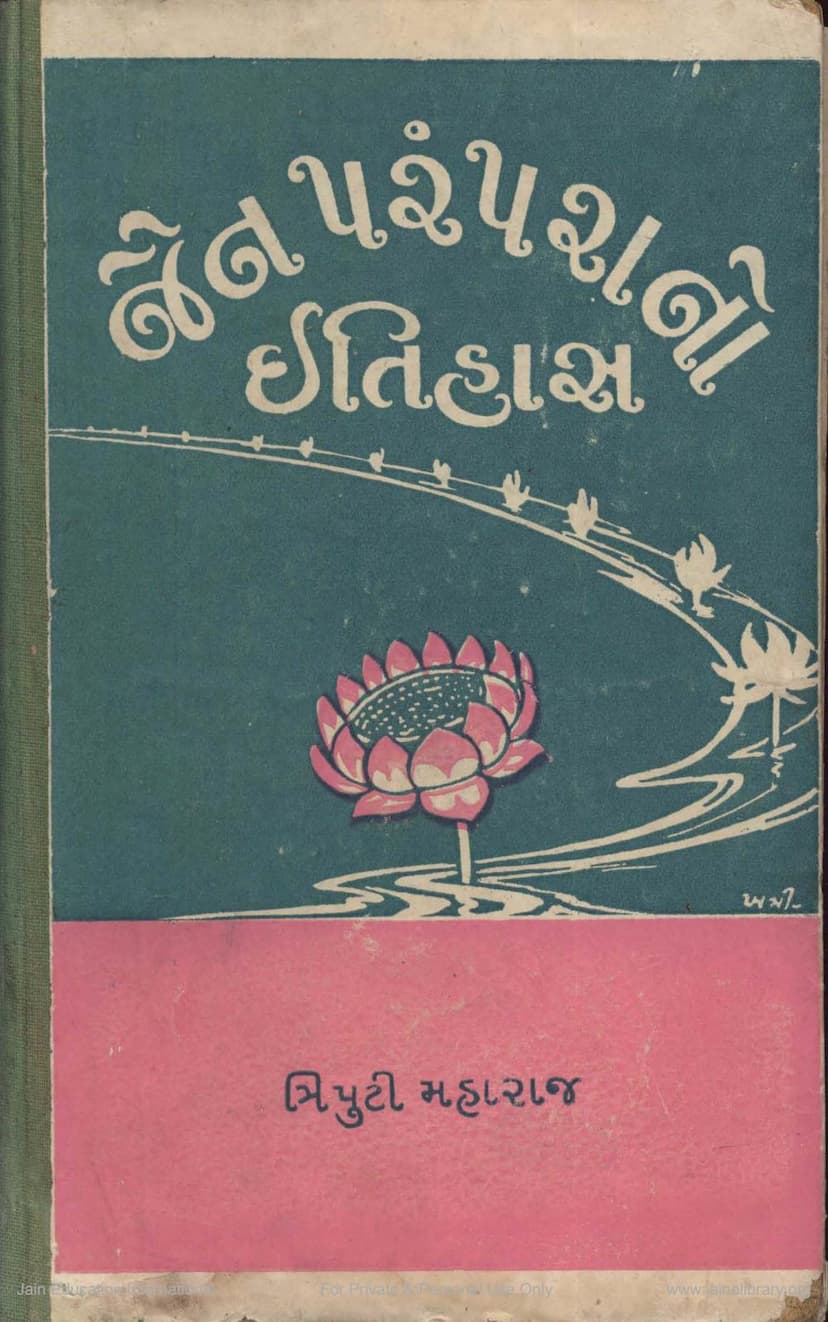Jain Paramparano Itihas Vol 3
Added to library: September 2, 2025

Summary
Here's a comprehensive summary of the provided Jain text, "Jain Paramparano Itihas Vol 3," based on the scanned pages and table of contents:
Book Title: Jain Paramparano Itihas Vol 3 (History of Jain Traditions Vol 3) Author(s): Munishri Darshanvijay, Munishri Gyanvijay, Munishri Nyayvijay (collectively known as Tripathi Maharaj) Publisher: Charitra Smarak Granthmala (Charitra Smarak Publication Series) Catalog Link: https://jainqq.org/explore/001078/1
Overall Summary:
This volume, the third in the "Jain Paramparano Itihas" series, continues the extensive historical documentation of Jain traditions, focusing on a specific period and lineage. The authors, through meticulous research and compilation from various ancient texts and inscriptions, aim to provide a detailed and chronological account of Jainism's historical development. This volume delves into the lives and contributions of prominent Jain monks, scholars, rulers, patrons, and the evolution of religious practices, texts, and institutions. It highlights the historical context of Jainism within broader Indian history, often referencing the influence of prevailing political and social conditions on religious and cultural practices.
Key Themes and Content Areas Covered:
- Genealogy of Acharyas (Gachhadhipatis): A significant portion of the volume is dedicated to tracing the lineage of Jain Acharyas, particularly within the Tapa Gachha and its various branches (e.g., Vridhha Tapagachha, Laghu Tapagachha, Karkachh, Nagari Tap). It details their succession, their philosophical contributions, their roles in upholding Jain principles, and their literary works.
- Prominent Figures: The text focuses on key historical figures, including:
- Acharya Jagachandrasuri: Described as a great ascetic ("Tapswi Hirla"), known for his profound knowledge of Agamas, his strict adherence to vows, and his role in strengthening the Tapa Gachha. His interactions with rulers like Rana Jaisingh and his contributions to Tirthoddhar (restoration of holy sites) are highlighted.
- Acharya Devendrasuri: A significant figure who followed Jagachandrasuri. He is noted for his peaceful teachings, his scholarship, and his influence on rulers, leading to the practice of Amari (prohibition of animal slaughter).
- Acharya Vijayachandrasuri: Mentioned as a successor who played a role in the eventual merging of some Tapa Gachha branches and the emergence of new practices.
- Other Prominent Acharyas and Munis: The volume details the lives and contributions of numerous other Acharyas and Munis associated with various Gachhas and lineages, including Acharya Hemkalash, Acharya Kshemkirti, Acharya Ratnakarsuri, Acharya Abhaydeva, Acharya Jaytilak, and many others, tracing their philosophical insights, literary works, and contributions to the spread of Jainism.
- Historical Context and Patronage: The text places the Jain tradition within its historical context, frequently mentioning the patronage of kings (like Rana Jaisingh, Rana Jaitrasimha, Rana Kumbha, Rana Pratap Singh, and various rulers of Gujarat), ministers (like Vastupal and Tejpal), and wealthy merchants. The influence of rulers and patrons on the establishment and restoration of Jain temples, the creation of libraries, and the propagation of Jainism is a recurring theme.
- Tirthas and Temples: The book meticulously details various Jain pilgrimage sites (Tirthas), temples, and their histories. This includes significant sites like Shatrunjaya, Girnar, Abu, Kesariya Ji, Virampur, Ranpur, and Ranakpur, discussing their restoration (Jirnoddhar), consecration (Pratistha), and the construction of new temples.
- Literary and Scholarly Contributions: The authors emphasize the extensive literary output of Jain scholars and Acharyas. They mention the composition of commentaries (Tika), philosophical treatises, biographies, devotional hymns (Stotras), and historical chronicles. The compilation and preservation of Jain scriptures in various Jain Bhandars (libraries) are also highlighted.
- Sects and Doctrinal Developments: The text touches upon the internal developments within Jainism, including the emergence of different sects or sub-sects within major gacchas, such as the differences that arose between Tapa Gachha branches and the emergence of the Lonkamat and Kadua Gachha, detailing their distinct practices and beliefs, and the conflicts or discussions they had with mainstream Jainism.
- Royal Patronage and Jain Influence: The text provides extensive information about the patronage of Jainism by rulers from various dynasties, particularly during the periods of the Solanki, Vaghela, Rajput (Mewar), and early Mughal dynasties. It highlights instances where rulers adopted Jain principles, promoted ahimsa (non-violence), granted tax exemptions, and funded the construction and maintenance of Jain temples and institutions.
- Mughal Period and Jainism: A significant portion of the volume covers the interactions between Jain Acharyas and Mughal emperors like Akbar and Jahangir. It details instances of dialogue, philosophical discussions, and the issuance of royal firmans (edicts) that protected Jain temples, granted privileges, and promoted ahimsa. The influence of Jain Acharyas like Acharya Hirvijaysuri on Akbar's policies is notably discussed.
- Social and Economic Aspects: The text also touches upon the social and economic roles of Jain communities, particularly mentioning wealthy patrons like Seth Shantidas Zaveri and his family, who significantly contributed to the preservation and promotion of Jainism. It discusses their involvement in trade, their establishment of charitable institutions, and their influence in political circles.
- Specific Details and Chronology: The book is rich in specific dates, names of individuals, places, texts, and events, providing a framework for understanding the historical progression of Jain traditions. The table of contents itself is a testament to the vast amount of detail covered.
Methodology and Approach:
The authors, likely drawing from their extensive knowledge of Jain scriptures and historical records, have presented a comprehensive and detailed historical account. The detailed table of contents suggests a systematic approach to documenting the succession of Acharyas, the biographies of key figures, the historical events, and the scholarly contributions of each era. The references to various texts and inscriptions indicate a foundation in primary source material.
Overall Significance:
"Jain Paramparano Itihas Vol 3" is a valuable resource for scholars, researchers, and anyone interested in the detailed history of Jainism. It provides a foundation for understanding the intricate development of Jain traditions, the lives of its guiding figures, its interactions with broader society, and its rich literary and architectural heritage. The volume's comprehensive nature underscores the long and complex history of Jainism in India.